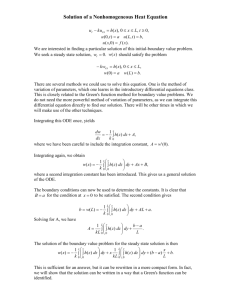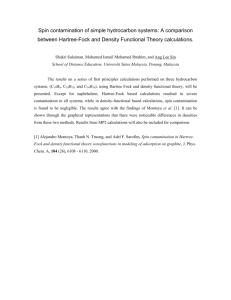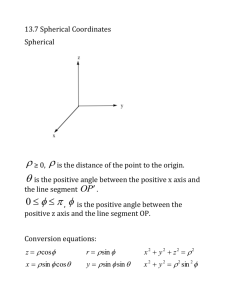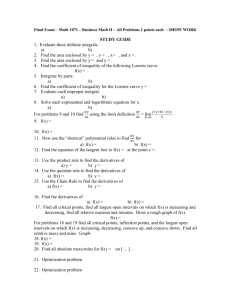3 Atomic and molecular science
advertisement
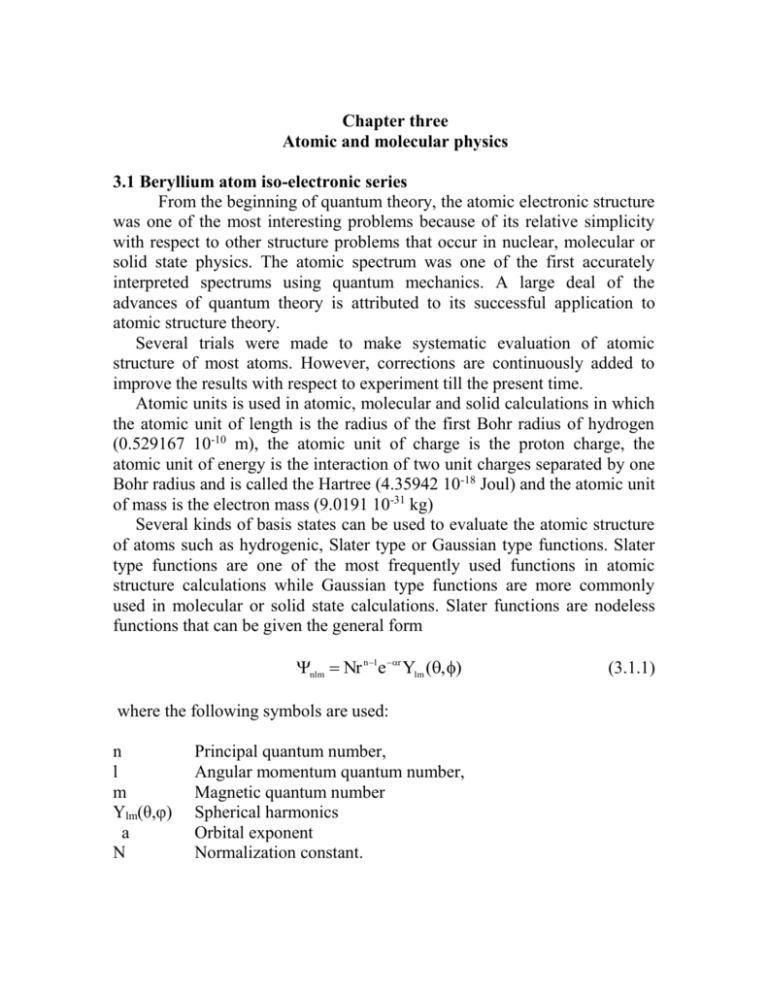
Chapter three Atomic and molecular physics 3.1 Beryllium atom iso-electronic series From the beginning of quantum theory, the atomic electronic structure was one of the most interesting problems because of its relative simplicity with respect to other structure problems that occur in nuclear, molecular or solid state physics. The atomic spectrum was one of the first accurately interpreted spectrums using quantum mechanics. A large deal of the advances of quantum theory is attributed to its successful application to atomic structure theory. Several trials were made to make systematic evaluation of atomic structure of most atoms. However, corrections are continuously added to improve the results with respect to experiment till the present time. Atomic units is used in atomic, molecular and solid calculations in which the atomic unit of length is the radius of the first Bohr radius of hydrogen (0.529167 10-10 m), the atomic unit of charge is the proton charge, the atomic unit of energy is the interaction of two unit charges separated by one Bohr radius and is called the Hartree (4.35942 10-18 Joul) and the atomic unit of mass is the electron mass (9.0191 10-31 kg) Several kinds of basis states can be used to evaluate the atomic structure of atoms such as hydrogenic, Slater type or Gaussian type functions. Slater type functions are one of the most frequently used functions in atomic structure calculations while Gaussian type functions are more commonly used in molecular or solid state calculations. Slater functions are nodeless functions that can be given the general form nlm Nr n 1e r Ylm (, ) where the following symbols are used: n l m Ylm(θ,φ) a N Principal quantum number, Angular momentum quantum number, Magnetic quantum number Spherical harmonics Orbital exponent Normalization constant. (3.1.1) The normalization constant N is given by N ( 2 ) n 1 2 [( 2n )!] 1 2 (3.1.2) On the other hand Gaussian orbitals have the factor r2 in the exponent which makes them a faster decaying function. This r dependence allows analytical evaluation of multi-center two-electron integrals. Although Hydrogenic wavefunctions have the same exponential structure as Slater wavefunctions, they generally differ in having nodes. The final solution is given as a linear combination of atomic orbitals (LCAO). This combination is restricted in angular momentum coupling rules which forbids some of these combinations. In this work we have been concerned with closed shell restricted Hartree-Fock equations. In these equations we must solve the simultaneous linear equations of the Fock Hamiltonian given by n (F 1 iS )Ci 0, 1,2,...,n (3.1.3) where n εI Cνi Sμν Fμν The number of orbitals, the one-electron energy, orbital expansion coefficients, the overlap integral, The Fock Hamiltonian. The overlap integral matrix element is given by S dv (3.1.4) where the integration is over all space. The Fock Hamiltonian matrix is n n 1 F H P [( ) ( )] 2 1 1 (3.1.5) where Hμν Pλσ (μν│λσ) the core Hamiltonian matrix element, the density matrix element, Two-electron integral. In atomic units (e=m= =4πε0=1) Hμν is given by 1 Z H ( 2 ) dv, 2 r (3.1.6) where Z is the atomic number of the atom. The first part in Eq. (3.6) is the kinetic energy matrix element while the second part is the potential energy matrix element. The density matrix element in Eq. (3.5) is given by occ. P 2 Ci Ci (3.1.7) i 1 The summation in Eq. (3.7) is over occupied orbitals only. The two-electron integral of Eq. (3.5) is given by ( ) (1) (1) 1 (2) (2)dv1dv2 r12 (3.1.8) where dv1 and dv2 are elements of space volume. The accuracy of the final total or orbital energy depends on the number of combined functions to form the atomic wave function. Singlezeta functions refer to the use of one Slater-orbital for each atomic level, double-zeta functions refer to the use of two Slater-orbitals for each atomic level…etc. the term zeta refer to the orbital exponent which is α in our notation. The overlap integral between Slater type orbitals in our case is given by S N N (n n )! n n ( ) 1 l l m m (3.1.9) The sub indices μ and ν refer to overlapping orbitals. In atomic units the potential energy matrix element is given by V ZN N (n n 1)! n n l l m m ( ) (3.1.10) The kinetic energy matrix element can be evaluated in the same manner but with more complex terms depending on the integrated orbitals. This six-dimensional two-electron integral can be reduced to a twodimensional integral after integrating the one-center spherical part of the Slater orbitals so that the remained integral that must be evaluated is of the form r R k R (1)R (1)( )k R (2)R (2)dr1dr2 r (3.1.11) where r> and r< are the greater and smaller of r1 and r2. Rμ is the radial part of the orbital Ψμ ...etc. To precede with our method the various matrix elements that are needed to solve the linear equations should be calculated. Afterward a suitable eigenvalue routine is used to obtain the eigenvectors and the total energy of the system. The two-electron integral is the most difficult part of the calculations. Complex analytical formalism for atoms exists for Slatertype orbitals. In this work we have adopted and tested numerical evaluation of two-electron integrals with the aim of generalizing this method to molecules or solids. The trapezoidal rule with 100 meshes in each direction is used to calculate the two-electron integral that is programmed in FORTRAN. An (IF) statement within the loop of integration is used to assign which of r1 and r2 is greater to complete the integration of Eq. (3.11). In order to solve the n Hartree-Fock equations, a trial wavefunctions 1, 2,.......n are used to calculate the Coulomb and exchange potential integrals and Hcore matrix elements. The n equations are solved to obtain another set of wavefunctions. The new wavefunctions are then used to calculate a new set of potential integrals and Hcore. The cyclic procedure continues till there is no change in the calculated wavefunctions or potential integrals and Hcore. This explains why this method is called self consistent field method since the final wave functions produce potential integrals and Hcore and those in turn produce the same wave functions within a given tolerance when Hartree-Fock equations are solved. The above procedure is shown fig. (3.1). The following tables from (1) to (4) show the results of the present calculations for the atom beryllium to four-electron nitrogen ion. start kinds of orbitals atomic calculation of S initial guess of the calculation of core wave function ( ) & H \_____________________|_____________________/ | ______ calculation of | F | | | solve the equations | (F- i S)c i= 0 | | | | | | | | no | |___ | calculation of P | calculation of Ee | Has energy converged? yes | end Figure (3.1.1): A flow chart of the computational procedure for obtaining electronic structure of atoms. Table (3.1.1) Be atom in multiple-zeta functions in comparison with Ref. [1] using the same reference orbitals and exponents. Experimental values are from Ref. [2]. Ref. [2] Present work Experiment Total energy (a. u.) -14.57301 -14.57285 -14.66797 1s (a. u.) -4.73270 -4.73268 Expansion 0.91117 0.91119 coefficients of the 1s 0.08527 0.08526 state 0.00095 0.00094 0.01673 0.01670 -0.00048 -0.00042 2s (a. u.) -0.30926 -0.30914 -0.34257 Expansion -0.16385 -0.16344 coefficients of the 2s -0.01659 -0.01675 state 0.51607 0.51642 -0.07243 -0.07290 0.55551 0.55529 Table (3.1.2) B+1 ion in multiple-zeta functions in comparison with Ref. [1] using the same reference orbitals and exponents. Experimental values are from Ref. [2]. Ref. [2] Present work Experiment Total energy (a. u.) -24.23756 -24.23732 -24.35251 1s (a. u.) -8.18593 -8.18579 Expansion 0.92801 0.92801 coefficients of the 1s 0.08063 0.08062 state 0.00320 0.00311 -0.00081 -0.00081 -0.00198 -0.00187 2s (a. u.) -0.87381 -0.87361 -0.92442 Expansion -0.20288 -0.20267 coefficients of the 2s -0.01942 -0.01948 state 0.73490 0.73541 -0.09218 -0.09247 0.34527 0.34485 Table (3.1.3) C+2 ion in multiple-zeta functions in comparison with Ref. [1] using the same reference orbitals and exponents. Experimental values are from Ref. [2]. Ref. [2] Present work Experiment Total energy (a. u.) -36.40848 -36.40818 -36.54467 1s (a. u.) -12.65064 -12.65050 Expansion 0.94114 0.94113 coefficients of the 1s 0.06483 0.06482 state 0.00453 0.00437 0.00033 0.00033 -0.00313 -0.00295 2s (a. u.) -1.69404 -1.69381 -1.75980 Expansion -0.23411 -0.23405 coefficients of the 2s -0.01534 -0.01534 state 0.81829 0.81884 -0.11736 -0.11753 0.28540 0.28492 Table (3.1.4) N+3 ion in multiple-zeta functions in comparison with Ref. [1] using the same reference orbitals and exponents. Experimental values are from Ref. [2]. Ref. [2] Present work Experiment Total energy (a. u.) -51.08231 -51.08195 -51.26460 1s (a. u.) -18.12014 -18.11985 Expansion 0.94954 0.94952 coefficients of the 1s 0.05374 0.05374 state 0.00616 0.00586 0.00230 0.00232 -0.00486 -0.00455 2s (a. u.) -2.76673 -2.76643 -2.84702 Expansion -0.25378 -0.25376 coefficients of the 2s -0.01283 -0.01281 state 0.86016 0.86122 -0.13747 -0.13762 0.26208 0.26109 We can see from the previous tables the good accuracy of the calculated total energies, 1s and 2s eigenvalues in comparison with experiment and other investigators. However, basis states expansion coefficients differ for small values. Correlation or relativistic corrections can be added to improve the results in comparison with experiments. These fine corrections are small since relativistic corrections are important only for high atomic number elements preferably 50. Relativistic corrections also affects inner electrons more seriously than outer electrons because of their higher speeds so that we expect 1s electron energies to have more errors than the 2s electron energies. On the other hand, experimental values of energies of inner electrons are less accurately determined and also less available especially for highly ionized atoms. Correlation corrections increase with the number of electrons so that it is expected that the present tables have more errors than the tables of helium iso-electronic serious. Suggestions to add the above mentioned corrections are highly recommended to see there effects on the accuracy of the present calculations. References [1]- E. Clementi and C. Roetti, Atomic and Nuclear Data Tables, V 14 P 1, (1974). [2]- C. Allen, ‘Astrophysical quantities’, William Clowes & sons, (1976). 3.2 Semiempirical self-consistent calculations Molecules differ from atoms by the multi-center of orbital electrons. Hcore is the matrix element of the Hamiltonian of a single electron in the field of the nuclei. Its operator representation M zA/r, Hcore =-1/2 2 - (3.2.1) A=1 where ZA is the charge of the nucleus A, the summation is over all atoms. Moreover, two-electron integrals are no more of one center. Multi- center integrals can reach now four-center integrals depending on the type of molecules. These differences makes the molecular calculations more difficult to perform. The main obstacle is that Slater orbitals are no more integratable and a replacement with Gaussian type orbitals is unavoidable. Ab-initio molecular orbital calculations are considered the most reliable method in the evaluation of electronic and physical properties of atoms, molecules, or solids. Less reliable methods are the semiempirical methods. Examples of semiempirical methods are CNDO (complete neglect of differential overlap) [1], INDO (intermediate neglect of differential overlap), and MINDO (modified intermediate neglect of differential overlap). Semiempirical methods make use of some of the quantities derived from experiment in addition to the neglect of some difficult and less effective parts of the exact calculations. On the other hand ab-initio methods do not use any empirical quantities and usually retains an essential part of the exact calculations. In the following we shall describe a numerical ab-initio method for the evaluation of the large number of integrals that appear in ab-initio methods for molecular orbital calculations. By an ab-initio calculation we mean the solution of Schrödinger equation using only the values of the fundamental physical constants (Planck's constant, velocity of light and the masses and charges of electrons and nuclei). This method involves the evaluation of large number of two electron repulsion integrals which is equal approximately to N4/8 where N is the number of electron basis. When the number of basis is large the evaluation of these integrals become a computer time problem. Some approximate approaches were suggested to avoid the evaluation of many of these integrals. One of these approximations is the complete neglect of differential overlap (CNDO) 1. The following approximations are applied in CNDO 1-Only valence electrons are considered. 2-Replacing the overlap matrix by the unit matrix. 3-Neglecting differential overlap in two electron repulsion integrals () (3.2.2) 4- Reducing the remaining two electron integrals to one per atom pair ()= ()= AB on atom A, on atom B. these integrals. s orbital are chosen for the evaluation of (3.2.3) 5- Neglecting monatomic differential overlap in the interaction integrals involving the cores of other atoms (|VB|)= VAB (3.2.4) 6- Taking diatomic off-diagonal core matrix elements to be proportional to the corresponding overlap integrals H = S 0AB on atom A, on atom B. (3.2.5) The remaining task is to specify the empirical parameters and remaining integrals suggested above. Two versions of CNDO parameterization were suggested. The second version CNDO/2 had better results than CNDO/1 and it is parametrized as follows. Each element is assigned a value for the empirical parameter 0A so that 0AB is given by 0AB= ½(0A+0B). (3.2.6) The electron-core potential integrals VAB is given by VAB= ZB AB (3.2.7) The local core matrix element U is given by U= -½ (I+A)-(ZA - ½)AA, (3.2.8) where I is the ionization potential and A is the electron affinity. The core Hamiltonian and Fock operator matrix is now given by H= -½ (I+A)+ ½ AA- ZCAC, (3.2.9) C H = ½(0A+0B)S, (3.2.10) F= -½ (I+A)-½( P-1)AA+ (PC-ZC)AC, (3.2.11) C F = ½ (0A+0B)S-½ PAB. (3.2.12) The main deficiency of CNDO approximations is the total neglect of exchange integrals. This deficiency is partially retained in the intermediate neglect of differential overlap (INDO) which is discussed in the following section. One very important advantage in CNDO or other methods of neglecting differential overlap is the straight forward applicability of relativistic corrections with no modification of the original CNDO equations. This is done by using the relativistic values of the empirical parameters 0AB and ½(I+A). All the other procedures or calculations remain with no change. This is possible since we can see that the only difference between the relativistic and non-relativistic calculations is in the matrix elements of the Hamiltonian which is represented by the above two empirical parameters. Partial account of exchange integrals is considered in INDO formalism. The one centre integrals are retained in INDO so that the Fock Hamiltonian is written in the form [1] F= U + [P( () - 0.5 ())]+ (PC-ZC)AC, (3.2.13) C F= P [1.5 ()- 0.5 ()] , on atom A (3.2.14) F = 1/2(0A+0B)S-1/2 PAB. on atom A, on atom B (3.2.15) For 2s and 2p orbitals, the non vanishing two electron integrals are given by Slater [12] ( 2s 2s 2s 2s ) = ( 2s 2s 2px 2px ) = F0 = AA (3.2.16) ( 2s 2px 2s 2px ) = G1/3 (3.2.17) ( 2px 2py 2px 2py ) = 3 F2/25 (3.2.18) ( 2px 2px 2px 2px ) = F0 + 4 F2/25 (3.2.19) ( 2px 2px 2py 2py ) = F0 - 2 F2/25 (3.2.20) All the above integrals are one centre integrals. The values of the experimental G1 and F2 are given by Slater [12] for the first row elements. However the determination of these two-electron integral from experiment for the large atomic number elements is impossible since relativistic effects will affect the values of the energy levels that is used to evaluate these integrals [Bransden]. The uncertainty of the assignments of some of the energy levels is another problem for the accurate evaluation of these integrals. However, these integrals can be evaluated from there theoretical definition as is explained in appendix A and as a consequence minimizing the dependence on experimental data. Fewer calculations are reported using INDO method in comparison with CNDO. Most of these calculations are centered on the first row elements. The inclusion of the exchange integral gives INDO the ability to distinguish the energy difference in atomic configurations such as the 3P, 1D, and 1S states. This makes INDO able to reach lower energy than CNDO when the coefficients of LCAO are varied to reach the minimum possible energy. All what we mentioned above concerning the relativistic corrections to CNDO is directly applicable to INDO method since the two methods share the same two empirical parameters namely 0AB and ½(I+A). In table (3.2.1) some of the results of the two above methods are shown for some light molecules. Table (3.2.1): Equilibrium bond length (E. B. L.) and binding energy (B. E.) for some light molecules in CNDO and INDO calculations in comparison with observed quantities (Obs.) [1]. Molecule E. B. L. E. B. L. E. B. L. B. E. B. E. B. E. CNDO INDO Obs. CNDO INDO Obs. 0 0 0 (A ) (A ) (A ) (eV) (eV) (eV) H2 0.746 0.746 0.742 5.37 5.37 4.75 Li2 2.179 2.134 2.672 14.71 14.40 1.05 C2 1.146 1.148 1.242 27.3 26.55 6.36 HF 1.0 1.0 0.917 6.77 6.3 6.11 BN 1.268 1.269 1.281 17.11 13.36 5.09 Reference 1 J. Pople and D. Beveridge, (1970), 'Approximate molecular orbital theory', McGraw-Hill. 3.3 Hydrogen fluoride molecule in ab-initio calculations The numerical evaluation of the Hydrogen fluoride molecule integrals can be performed in several methods that range from the simple trapezoidal method to complicated and sophisticated Gauss-Legendre method [7]. In table (3.5) we compared the results of integrating the overlap integral of the 1s state (which has the value of unity (normalized)) of fluorine atom by both the Simpson and trapezoidal methods using P1 233 MHz computer. The results show that for equal number of meshes the Simpson rule has a marginal better performance than the trapezoidal rule. However, the timing of the two methods shows that the trapezoidal method has better performance for Slater type orbitals. This case is also referred to in other situations [7]. The number of meshes used in this work is 200 meshes in each Cartesian direction for overlap and core-Hamiltonian integrals. Table (3.3.1): Comparison of the trapezoidal and Simpson rules in evaluating the overlap integral of the 1s state with its self. 100 meshes 200 meshes 300 meshes Trapezoidal 0.99993711 0.99999598 0.99999915 (value) Trapezoidal 6 53 105 (time (sec)) Simpson 0.99994633 0.99999655 0.99999926 (value) Simpson 43 340 1145 (time(sec)) Analytical formulas are usually available for one and two-center integrals for Slater type orbitals. However, formulas for multiple-center integrals are unavailable. In previous work we compared the numerical evaluation of restricted Hartree-Fock of one-center integrals (atoms), in this work we shall describe the accuracy of numerical evaluation of two-center integrals (diatomic molecules). Hydrogen fluoride molecule is chosen for this purpose since the detailed analytical calculations of this molecule is found in reference [1]. In all the following matrices the rows or columns represents the 1s, 2s, 2px, 2py, and 2pz of fluorine orbitals while the last row or column represents the 1s state of hydrogen. These include the following orbitals for the Fluorine 1 = ( 15/ 3)1/2 r exp(-1 r) (3.3.1) 2 = ( 15/ )1/2 z exp(-1 r) (3.3.2) 3 = ( 15/ )1/2 x exp(-1 r) (3.3.3) 4 = ( 15/ )1/2 y exp(-1 r) (3.3.4) and the following orbital for the hydrogen atom 5 = ( 23/ )1/2 exp(-2 r) where (3.3.5) 1= 2.6, (3.3.6) 2= 1.0. (3.3.7) Overlap integral matrix of hydrogen fluoride molecule is evaluated analytically in reference [1]. This matrix is given by the following: 0 0 0 1.0000 0.2377 0.2377 1.0000 0 0 0 0 0 1.0000 0 0 S 0 0 1.0000 0 0 0 0 0 0 1.0000 0 0 0.0548 0.4717 0.2989 0.0548 0.4717 0.2989 . 0 0 1.0000 (3.3.8) Using the orbital exponents of reference [1], overlap integral matrix evaluated numerically in the present work is given by the following: 0 0 0 1.0000 0.2377 0.2377 1.0000 0 0 0 0 0 1.0000 0 0 S 0 0 1.0000 0 0 0 0 0 0 1.0000 0 0 0.0548 0.4717 0.2989 0.0547 0.4717 0.2989 . 0 0 1.0000 (3.3.9) Core Hamiltonian matrix of reference [1] is given by: 0 0 2.1798 41.0320 9.4019 0.0162 9.4019 11.1462 0.1775 0 0 4.3051 0.0162 0.1775 8.9692 0 0 2.2822 H 0 0 0 8 . 8548 0 0 0 0 0 0 8.8548 0 0 0 5.2499 2.1798 4.3051 2.2822 (3.3.10) Core-Hamiltonian matrix in the present work is given by: 0 0 2.1798 41.0320 9.4019 0.0161 9.4019 11.1462 0.1774 0 0 4.3049 0.0161 0.1774 8.9691 0 0 2.2822 H 0 0 0 8.8547 0 0 0 0 0 0 8.8547 0 0 0 5.2499 2.1798 4.3049 2.2822 (3.3.11) Note that in semiempirical calculations the 1s orbital of the fluorine is neglected and the above matrices are changed to square matrices with 5 elements in each direction. The overlap matrix is approximated by a unit matrix in semiempirical calculations. The two-electron integral values in the present work are given in table (3.6) in comparison with the results of reference [1]. Since the two-electron integral is a six-dimensional integral a limited number of meshes (16 meshes in the present work) for each direction can be given. Table (3.3.2): Two-electron integrals (μν│λσ) of reference [1] compared with the present calculations μ ν λ σ Reference [3] Present work 1 1 1 1 5.43750 5.43745 2 1 1 1 0.79103 0.79082 2 1 2 1 0.14633 0.14623 2 2 1 1 1.29075 1.29074 2 2 2 1 0.29564 0.29545 2 2 2 2 0.94453 0.94451 3 1 3 1 0.03104 0.03102 3 2 3 1 0.04683 0.04678 3 2 3 2 0.20877 0.20874 3 3 1 1 1.29075 1.29074 3 3 2 1 0.29564 0.29545 3 3 2 2 0.94453 0.94451 3 3 3 3 1.01766 1.01761 4 3 4 3 0.05484 0.05483 4 4 3 3 0.90797 0.90887 6 1 1 1 0.19478 0.19403 6 1 2 1 0.03452 0.03438 6 1 2 2 0.06818 0.07014 6 1 3 1 0.00120 0.00114 6 1 3 2 0.00234 0.00239 6 1 3 3 0.06835 0.07016 6 1 4 4 0.06809 0.07013 6 1 6 1 0.00825 0.00814 6 2 1 1 0.44958 0.46318 6 2 2 1 0.10438 0.10606 6 2 2 2 0.36762 0.39247 6 2 3 1 0.00611 0.00601 6 2 3 2 0.04344 0.04234 6 2 3 3 0.37464 0.39763 Eigenvalues of hydrogen fluoride molecule in the present method compared with the calculated values of reference [1] is given in table (3.7). Table (3.3.3): Eigenvalues of hydrogen fluoride molecule in atomic units (a. u.) Molecular orbital Reference [3] Present work 1σ -26.139 -26.143 2σ -1.476 -1.455 3σ -0.566 -0.402 1π -0.465 -0.366 1π -0.465 -0.366 4σ 0.477 0.469 Expansion coefficients of eigenvectors of Fock-Hamiltonian matrix in reference [1] is given by the matrix 0.0163 0.024 0 0 0.0046 0.9963 0.2435 0.9322 0.0907 0 0 0.1606 0.0839 0.4715 0.6870 0 0 0.5761 C 0 0 0 1 . 000 0 0 0 0 0 0 1.000 0 0 0 1.0502 0.0800 0.5599 0.8065 (3.3.12) Expansion coefficients of eigenvectors of Fock-Hamiltonian matrix in the present work is given by 0.0167 0.0023 0 0 0.0054 0.9962 0.2607 1.0514 0.1129 0 0 0.05748 0.05203 0.3395 0.7119 0 0 0.5663 C 0 0 0 1.000 0 0 0 0 0 0 1.000 0 0 0 1.0660 0.0466 0.4288 0.7815 (3.3.13) The total electronic energy of hydrogen fluoride is given in table (3.8) Table (3.3.4): The total electronic energy of hydrogen fluoride molecule in the present work compared with reference [1] and experiment [8]. Total electronic Experimental total Total electronic energy in energy of reference [3] electronic energy [8] present work in a. u. in a. u. in a. u. -104.67184 -105.72 -104.62534 Note that the total energy calculated in semiempirical methods does note include the energy of the 1s orbital of the fluorine [1], and consequently can not be compared with calculated or experimental values of table (3.8). The analytical evaluation of Hartree-Fock integrals is a tedious job both in deriving and programming formulas for this purpose. In addition the number of formulas to be derived and programmed always increases as the kind of orbitals changes. The reverse situation is true for numerical integration since no additional programming is needed for any new type of wavefunctions. Some integrals are never derived nor programmed (three and four-center integrals). The use of Gaussian basis is a way to turn around the problem in which the analytically programmed formulas are easier [9]. Previous numerical routines for evaluating atomic or molecular electronic structures can be found in literature [10]. In the present work a numerical routine is suggested for molecules. This method has been described previously for atoms [11] and has the following properties and advantages: 1- The accuracy of evaluating three-dimensional integrals (overlap and core-Hamiltonian integrals) has better results than the six-dimensional two-electron integrals in comparison with analytical derivation because of the limitations on the number of meshes. 2Some of the two-electron integrals are neglected in the semiempirical methods [1] such as (11│11) in addition to ignoring the differences between others such as (22│22) and (33│33). This is not the case in abinitio methods. This also shows the superiority of ab-initio methods upon semiempirical methods. 3The neglect of the inner core electrons in semiempirical methods which is not the case in the present method. 4No trail is made to make use of experimental quantities in ab-initio methods, which is not the case in semiempirical methods. In fact only the electron and nuclei charges and masses are used in ab-initio method. 5- Finite differences in the final eigenvalues of the molecule exist between numerical and analytical methods that are of the order of 0.2 a. u. in the present case as in table (3.7). This difference depends on computer speed and can be reduced by increasing the number of integration meshes. 6The value of the total energy is in a good agreement both with analytical and experimental values as in table (3.8). This value can be improved further in several ways such as the inclusion of correlation or relativistic corrections [12,13]. The use of additional basis states can also push the total energy to reach the limiting value of Hartree-Fock method [3]. The total energy in the semiempirical methods include the valance electrons only and neglect core electrons so that no comparison can be made with the total calculated or experimental energy 7The trapezoidal rule is found convenient and time consuming for evaluating Hartree-Fock integrals of Slater type orbitals. This is the case since Slater type orbitals have one or two minimums or maximums along all space. Simpson rule for example increases computer time significantly with lateral increase in accuracy. The main deficiency of Hartree-Fock theory is the lack of correlation between motions of electrons. Correlation energy is defined as the difference between the Hartree-Fock and exact (non relativistic) energy4 E(exact)=E(Hartree-Fock)+E(correlation) (3.3.14) The correlation correction to the initial error inhibited in Hartree-Fock calculations is due to the fact that only one single determinant is included in Hartree-Fock calculations. One obvious example of correlation correction importance is the F2 molecule. This molecule is predicted to be unstable in the exact Hartree-Fock calculations [4,5]. However adding correlation corrections to the Hartree-Fock calculations will result in nearly the exact experimental bond dissociation energy. This deficiency is also obvious when we try to describe the dissociation of a hydrogen molecule to two separate hydrogen atoms [4]. The dissociated hydrogen molecular wave functions in Hartree-Fock calculations is contaminated with incorrect components that attach the two electrons to one atom. In order to correct this error several determinants should be included in the calculations. This method is called configuration interaction (CI) which relays on the variation of the energy of multiple-determinant wave functions to obtain the lowest possible energy of the system. The simplest CI calculations that can be performed include the highest occupied molecular orbital (HOMO) and the lowest unoccupied molecular orbital (LUMO). These calculations are frequently called HOMOLUMO calculations. Since the hydrogen molecule has only two basis states a full configuration interaction can be performed with the HOMO-LUMO type calculations. In order to perform these calculations, the two electron repulsion integrals and core Hamiltonian integrals should be transformed in terms of the final Hartree-Fock molecular orbitals [6] ( i j k l) = c i * c * c c ( ), i k l Hij = c i * c H i (3.3.15) (3.3.16) Other methods of correlation are available and are widely used to correct the calculated Hartree-Fock total energy and to bring this energy nearer to the experimental one. One of these methods which can be applied to molecular calculations is the Moller-Plesset perturbation method [7,8,4]. All correlation methods have the effect of bringing the electronic properties nearer to the experimental one. The effects of correlation corrections are made clear in table (1.1) which compares the dissociation energy calculated in Hartree-Fock method before and after adding correlation corrections by Moller-Plesset perturbation method [4]. Moller-Plesset perturbation method are not a variational method as the CI methods but it has the advantage of being size consistent[4]. By size consistency we mean that the relative error of the method increases with the size of the molecule or the solid. This is important when we tray to compare these errors for different sizes of the molecule or the solid. Another advantage is the gained computational time of the calculations. Unlike CI calculations Moller-Plesset perturbation method does not need a total transformation of the two-electron integrals of Eq.(1.17). Only a partial transformation is needed for this method as will be explained below. In this method the correlation Hamiltonian is written as a perturbation over the exactly solvable Hartree-Fock Hamiltonian H = H0+ H' (3.3.17) where H is the total Hamiltonian, H0 is the Hartree-Fock Hamiltonian and H' is the correlation correction. is a dimensionless parameter which goes to 0 for H = H0 , and might be given the value 1 for H = H0+ H'. The wave function of the k level of the total Hamiltonian is now given by k = k(0) + k(1) + 2k(2) + 3k(3) + ...... (3.3.18) and the energy of this level becomes Ek = Ek(0) + Ek(1) + 2 Ek(2) + 3 Ek(3) + .... (3.3.19) The correlation correction of the Hamiltonian H' is given by H' = ( i j a b ) (3.3.20) where ( i j a b ) is related to the two electron integral of Eq.(1.11) by ( i j a b )= ( i a j b ) - ( i b j a ) (3.3.21) The first contribution to the energy of the k level is given by Ek(1) = k H' k = H'kk (3.3.22) The second contribution to the energy of the k level is given by Ek(2) = mk H'km 2 / (Ek - Em) (3.3.23) This method will be used in this work since size consistency is more important in the case of solid calculations than in molecular calculations which will give a comparative study of this correction when used for different sizes used for the solid calculations. The second feature of this method which is the time reduction is also very important in the solid case because of the large number of basis states which makes the time reduction of any correlation correction method of a vital importance for the applicability of this method. Table(3.3.5) which compares the dissociation energy calculated in HartreeFock method before and after correlation corrections are made [4]. Energies are in eV. Hartree-Fock after correlation Experimental energy corrections H2 3.68 4.38 4.72 HF 4.03 5.68 6.11 CH 2.47 3.16 3.64 OH 2.95 4.16 4.64 NH 2.2 3.08 3.42 F2 -1.43 1.52 1.65 References 1- J. Pople and D. Beveridge, (1970), 'Approximate molecular orbital theory', McGraw-Hill. 2- J. E. Szymanski, ‘Semiempirical methods of total energy calculations’,Ph. D. thesis submitted to the University of York (1984). 3- W. Hehre, L. Radom, P. Schileyer, and J. Pople, (1986), 'Ab initio molecular orbital theory', John Wiley & Sons. 4- B. Bransden and C. Joachain, (1984), 'Physics of atoms and molecules', Longman. [5]- B. Shore and D. Menzel (1968), ‘Principles of atomic spectra’, John Wiley & Sons. [6]- J. Slater, (1960), ‘Quantum theory of atomic structure’, McGrawHill book company. [7]- E. Schmid, G. Spitz and W. Losch, (1988), 'Theoretical physics on the personal computer', Springer-Verlag. [8]- C. Allen , (1976), ‘Astrophysical quantities’, William Clowes & sons. [9]- R. Daudle, G. Leroy, D. Peeters and M. Sana, ‘Quantum chemistry’, John Wiley & Sons. [10]- M. Defranceschi and J. Delhalle, (1989),‘ Numerical determination of the electronic structure of atoms, diatomic and polyatomic molecules’, Kluwer academic publishers. [11]- M. Abdulsattar and K. H. Al-Baiati, accepted for publication in the Journal of the Collage of Science, Saddam University [12]- F. King, D. Ballegeer, D. Larson, P. Pelzl, S. Nelson, T. Prosa and B. Hinaus, (1998), Phys. Rev. A, V 58, P 3597. [13]- D. Feldmann, P. Pelzl and F. King, (1998), J. Math. Phys., V 39, P 6262. Questions 1- How can we apply Hartree-Fock method to nuclear structure problems? What are the difficulties that arise in such application? 2- The following matrix represent the overlap matrix of the hydrogen fluoride molecule in ab-initio calculations. Transform this matrix to CNDO and INDO approximations knowing that the hydrogen fluoride molecule is represented by the following orbitals in ab-initio calculations: 1s, 2s, 2px, 2py, 2pz for the fluoride molecule and 1s orbital for the hydrogen molecule. 0 0 0 1.0000 0.2377 0.2377 1.0000 0 0 0 0 0 1.0000 0 0 S 0 0 1.0000 0 0 0 0 0 0 1.0000 0 0 0.0548 0.4717 0.2989 0.0548 0.4717 0.2989 0 0 1.0000 3- A number of two-electron integrals is given below. Show which of these integrals are neglected in CNDO or INDO theory knowing that orbitals 1, 2 are on the same atom. (11│11), (12│12), (21│11), (13│31)

